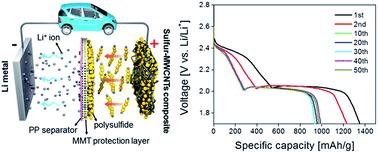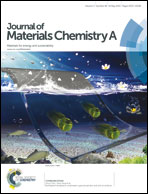Interaction mechanism between a functionalized protective layer and dissolved polysulfide for extended cycle life of lithium sulfur batteries
Abstract
To improve the cycle life of Li–S rechargeable batteries, chemically dispersed nanocarbon materials are usually employed as adsorbents and conductive matrices for cathodic nano-sized sulfur materials. Herein, a new assembly for Li–S cells is developed by introducing a montmorillonite (MMT) ceramic protective film to form an ion selective separator. The effect of the MMT-coated separator and the reaction mechanism between MMT and polysulfides are characterized via Raman and zeta potential analyses. The utilization of the MMT coated separator enables the minimization of the shuttle effect by preventing the diffusion of polysulfide. The best discharge capacity and cycle life are obtained with the MMT coated separator in a sulfur–MWCNT composite cathode, resulting in a discharge capacity of 1382 mA h g−1 at a current density of 100 mA g−1 and 924 mA h g−1 after 200 cycles. The Li–S cell using the nano-sized sulfur–MWCNT composite and the MMT-coated separator shows significantly excellent electrochemical performance.


 Please wait while we load your content...
Please wait while we load your content...